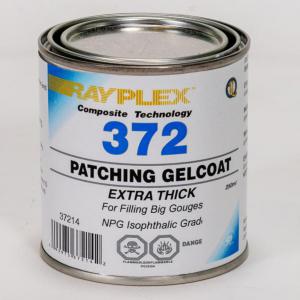PATCHING GELCOAT 237ml c/w Catalyst
Click Picture for more Info
Rayplex #372 Patching gelcoat is used for fiberglass boat maintenance and repair. Gelcoat is the outer layer of a fiberglass boat's hull or surface and provides both a protective and aesthetic finish. Over time, it can become damaged or develop cracks, chips, or other imperfections that need to be patched or repaired. Here's a general guide on how to patch gelcoat using our extra thick no sag patching gelcoat.
Materials and Tools You'll Need:
1. Gelcoat repair kit
2. Gelcoat color matched to your boat's original gelcoat
3. Gelcoat catalyst comes with the patch kit
4. Acetone
5. Sandpaper grits from 80 to 600 Plus rubbing compound
6. Masking tape
7. Paintbrush or roller
8. Plastic or metal putty knife or spreader
9. Disposable gloves
10. Safety glasses or goggles
11. Dust mask (if sanding)
Steps to Patch Gelcoat:
1. Preparation:
• Start by cleaning the damaged area thoroughly with acetone to remove any dirt, wax, or grease.
• Sand the damaged area lightly with coarse sandpaper (80-100 grit) to roughen the surface and create better adhesion for the new gelcoat.
2. Masking:
• Use masking tape to create a border around the damaged area, ensuring that you have a clean, defined edge for the repair.
3. Mix the Gelcoat:
• Follow the instructions on the gelcoat patch kit to mix the gelcoat with the catalyst. Typically, you'll use a small amount of catalyst per the Rayplex's recommendations. Stir thoroughly to ensure it's well-mixed.
4. Apply the Gelcoat:
• Use a spreader or putty knife to apply the mixed gelcoat evenly to the damaged area. Apply it slightly above the surface level to allow for sanding later. Make sure the gelcoat fills the entire damaged area.
5. Level and Smooth:
• While the gelcoat is still tacky but not completely cured, use a plastic or metal putty knife or spreader to smooth and level the gelcoat. Feather the edges to blend it with the surrounding surface.
6. Let it Cure:
• Allow the gelcoat to cure for at least 3 hrs. This typically takes several hours to overnight, depending on temperature and humidity.
7. Sand and Polish:
• Once the gelcoat is fully cured, use progressively finer sandpaper (e.g80 -180 grit) to sand the patched area smooth. Be gentle and take your time to avoid damaging the surrounding gelcoat.
8. Clean Up:
• Remove the masking tape and clean any residue with acetone.
Remember to work in a well-ventilated area and wear appropriate safety gear, including gloves, safety glasses or goggles, and a dust mask if sanding
Featured positive reviews:
Everything was received in a timely manner. Product was fresh, fixed the rock rash on my fiberglass hull beautifully. Very informative website, don't need to be pro.




